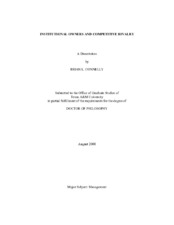| dc.description.abstract | Scholars have increasingly recognized the importance of institutional owners in
the life of the firm and have sought to explain how and when these owners influence
firm-level strategies. In spite of evidence that these owners can and do affect broad
strategies, there is little empirical support for the extent to which institutional investors
involve themselves at the level of strategic competitive actions that firms undertake. This
raises the question: "How do different types of institutional investors affect strategic
competitive activity between firms?" Further, owners have a unique bearing on
competitive activity insofar as they can simultaneously influence firms that are
competing with each other. Therefore another important question is: "How are the
relationships between institutional investors and strategic competitive activity affected
when those investors hold stakes in both the focal firm and their competitor?" Borrowing from the accounting literature, this dissertation classifies institutional
owners into three groups based on their historical trading behavior: transient, dedicated,
and quasi-indexer. Findings from examination of the ownership holdings and strategic
competitive activity of thirty-six Fortune 500 rivalries over the years 1997-2006 provide insight into these questions. High levels of dedicated institutional ownership are
associated with greater strategic competitive activity whereas high transient institutional
ownership is associated with low strategic competitive activity. The relationship between
dedicated ownership and strategic competitive activity is moderated by common
ownership of a focal firm and its rival. As dedicated ownership of the focal firm and its
rival increase together, strategic competitive activity is reduced. The results presented
here change the way we apply agency theory to explain firm governance. For competitive
dynamics researchers, this study points to a previously unexplored means by which firms
are motivated to engage, or not engage, in competitive activity. This study also has broad
implications for managers, investors, and policymakers. | en |


